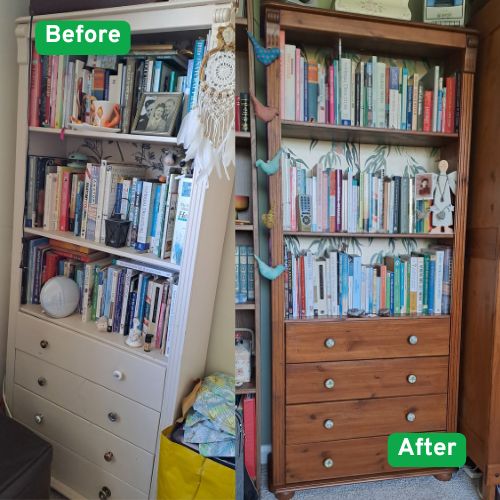Learning to Be Okay: Returning Solo to Italy If you’ve...
Read More
On upcycling, letting go of appearances, and living more truthfully , inside and out
After writing about soulfully living, I found myself drawn to a quiet, unexpected lesson, not in a meditation or retreat, but while sanding down an old piece of furniture.
At first glance, the piece was charming, painted in soft tones, adorned with quirky mismatched knobs. It had personality, a kind of curated eccentricity. But something about it didn’t feel entirely true. In truth, didn’t dislike it, not at all, but I could sense there was something underneath waiting to be seen. Like it was performing, beautiful, but hiding behind its layers.
Wanting to see it stripped back, honest, natural, and not made desirable by what covered it the process of stripping paint began. Followed by smoothing rough edges, and staining the wood with a warm, earthy tone, a process that, to my surprise, fought me at every turn.
The paint clung stubbornly. Screws refused to align. It would not come apart easily, nor back together gracefully. And yet, I persisted. Not because it was easy… it wasn’t, but because something in me needed to see it through.
The process demanded patience. Consistency. Gentleness in the face of resistance. And in that slow, deliberate process, I realised: I was learning about myself.
There was something humbling about watching the piece return to its raw state. No paint, just wood, with its natural grain, its imperfections, its quiet strength. upcycling by down playing.
It reminded me how often we dress ourselves — not just in clothes or makeup, but in behaviours, attitudes, smiles — to make ourselves more palatable, more desirable, more “put together.” Sometimes we do it out of creativity and joy. But often, it’s out of fear. Fear that the raw self won’t be enough. That our true texture, our natural grain, might be too much… or not enough.
The process of stripping back, of letting go of those coverings, is hard. It’s messy. It doesn’t always feel good. There were moments I wanted to give up. Times when I wondered if I was ruining something already beautiful in its way. And that’s the thing, not everyone would have agreed with what I saw underneath. Some may have preferred the version with its layers intact. Some might not like the final result either.
But I wasn’t upcycling it to please anyone else.
I was doing it to meet the piece and myself in truth. In simplicity. In quiet, grounded honesty.
Just like we layer ourselves, we layer our spaces too.
We fill our homes with objects, colours, and styles, sometimes from the heart, sometimes from habit, sometimes to impress or distract. And the people we surround ourselves with? They can either honour our natural state or unknowingly encourage us to keep the layers on.
It’s worth asking: do the spaces we live in, the energy around us, and the relationships we tend, do they reflect who we are underneath it all? Or do they reinforce the version of us we’re trying to outgrow?
That old piece of furniture now sits in my space, not loud or flashy but honest. It feels like an ally in my journey, a reminder that beauty doesn’t always need polish and that truth, even when it takes effort, always feels like home.

Prompts for Soulful Reflection
Let these questions meet you gently:
There was something else that surfaced during this whole process, something more vulnerable.
As I worked on that piece, stripping it back layer by layer, I found myself thinking about beauty, not just in furniture, but in myself. About how easy it is to feel unattractive when life changes you. When you’re no longer living inside the shape of the life you imagined.
Since my separation, it’s been eight years of navigating life on my own through divorce, rebuilding, and rediscovering. And I’d be lying if I said that journey hasn’t touched how I see myself. There’s something about being single for so long after a marriage that can quietly challenge your sense of desirability. Not because your worth is less, but because the reflection you once relied on, someone seeing you, wanting you is no longer there.
You start to ask: Am I still beautiful? Still wanted? Still enough?
There are days the answer comes softly. And others when it doesn’t come at all. But what I’ve learned is that beauty isn’t always about being seen by someone else. Sometimes it’s about learning to witness yourself — raw, changed, wiser — and still feel something tender stir.
That’s what upcycling and restoring that piece of furniture gave me. A mirror. A process. A quiet understanding that being stripped back doesn’t mean being less. It means revealing what was always there, the truth, the texture, the strength. And in that, there’s a different kind of beauty. One that doesn’t need to perform.

So much of soulful living is about learning to stay with the process, with the discomfort, with the beauty we didn’t know was ours. Just like that old, stubborn piece of furniture, we are not here to be perfect or polished. We are here to be real. To be whole. To be fully seen, in our knots and grains and warmth.
If you’re in a season of stripping back, of letting go of roles, relationships, or ways of being that no longer fit, know this: it’s brave. And it’s worth it.
Keep going. not to survive, not to say you endured. You keep going so that you can watch as you reveal, understand and become the real you.
A mantra for the journey:
I trust the beauty beneath the layers. I honour the truth of who I am becoming.
If you’re thinking about physically stripping back paint from furniture, there are a couple of viable options — three, if you count sandblasting (though that’s best left to professionals or very sturdy pieces).
Whichever method you choose, the key is patience. Just like personal growth, if you rush the process, you risk damage. But with care and consistency, what lies beneath is often more beautiful than you imagined.
See here the paint stripper I used.
Disclaimer: This blog is a personal reflection and is for entertainment and educational purposes only. It does not constitute medical or therapeutic advice. Please consult a healthcare professional for guidance specific to your situation.
Learning to Be Okay: Returning Solo to Italy If you’ve...
Read MoreWe Become What The Nervous System Remembers: Survival V’s Healing...
Read MoreWhen the Nervous System Remembers: Reimagining Italy After a Hard...
Read MoreThe Layers We Shed How upcycling a piece of furniture...
Read MoreLike this article?
Leave a comment